HANDBOOK CARBON


Dear Carbon-based Lifeform,
Welcome to the curious and complex world of carbon. It forms the backbone of our DNA, is key to life maintaining processes like photosynthesis and respiration, and drives our industries. Our ability to control and manipulate carbon—whether as charcoal, oil, or plastic—has revolutionised every aspect of the way we live. From medicine and machinery to architecture and art—the sooty fingerprints of carbon are visible on almost everything humanity has built.
This activity handbook is a learning resource that encourages engagement with the different forms of carbon present in our lives. It contains instructions for experiments, projects and even recipes that can be done both inside a classroom as well as outside of it. We hope that by trying out these activities you gain insights about the presence and nuances of carbon in our daily life.
Jump in to understand carbonation by trying out fizzy drinks, or calculate how much carbon is sequestered in trees by taking an extended nature walk. Explore the interesting properties of the carbon found inside of pencils. Learn about valency and chemical bonds by creating your own element embroidery art!
Create, experiment and observe carbon in the world around you through these activities that we have put together for you. Don’t forget to share your findings and creations with us, by tagging us on social media. Use the hashtags #CARBON and #ExperimentWithSGB to see what others have created!
Warmly, Science Gallery Bengaluru
01





LET’S GET FIZZY! INTO THE NANOVERSE 14 04 TURN OVER A NEW LEAF ELEMENT EMBROIDERY 18 08 CURCUMIN CLICKS 26 CONTENTS





DEAR (DIGITAL) DIARY, FUEL FOR THOUGHT 32 38 A FOOTE-NOTE IN CLIMATE HISTORY 44 CHOREOGRAPHING CARBON 50 LIFE IN PLASTIC: IS IT FANTASTIC?
AND REFERENCES 54 58
GLOSSARY
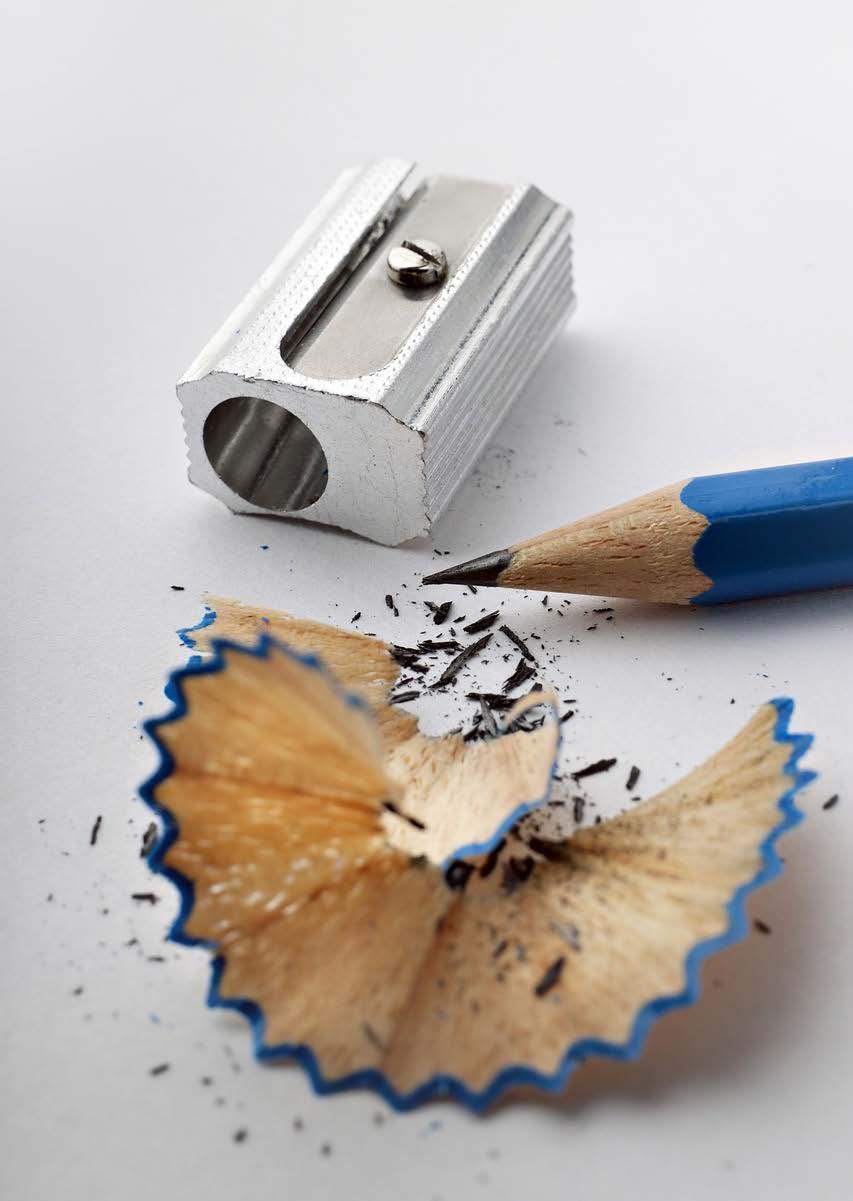
CARBON | 2023 04
INTO THE NANOVERSE
It is 100 times stronger than steel. It is a better electrical conductor than copper. It is only as thick as a single layer of atoms. And, you can find it in pencils. Yes, you heard that right! This fantastical material is none other than graphene, the latticed sheets of carbon that make up the graphite in our pencils.1
In 2010, physicists Andre Geim and Konstantin Novoselov won the Nobel Prize in Physics for their work on graphene. Using commonly available Cellotape, they peeled off layer after layer of a piece of graphite, until they isolated the first singlelayer material ever discovered—graphene.2
The applications of this material can be found in a diversity of fields, from biomedical to electronics. The efficient conducting ability of graphene has the potential to increase computing power in electronics. Graphene-based transistors display greater sensitivity and conductivity than silicon-based equivalents, owing to their property of being ultra thin.3
It doesn’t stop there. Roll up a sheet of graphene into a tube and you have a carbon nanotube. These strong fibres can strengthen textiles, be used to make vascular stents, as well as to create conductive plastic.4 Carbon nanotubes have been used to produce the darkest substance known to us, named Vantablack, a coveted and controversial material.5
Setting records for being the hardest and darkest, this remarkable material has been hiding in plain sight—within the wooden outfit of a pencil. In this activity, explore the properties of graphene, and imagine the world at the nanoscale with the help of a simple circuit.

1 Science and Industry Museum, 2021.
2 Ed Gerstner, 2010.
3 Wassei and Kaner, 2010.
4 Nguyen and Nguyen, 2016.
5 Rogers, 2017.
05
MATERIALS REQUIRED:
1. Pencil (preferably 9B pencil)
2. Paper
3. Insulated copper wires
4. 9V Battery
5. LED
6. Switch (optional)
How to use a switch in a circuit?
A switch typically consists of three terminals. The middle terminal is the input and the other two are outputs. The wire coming from the positive terminal of the battery should be connected to the middle terminal and the wire going to the negative terminal of the battery can be connected to any one of the side terminals.
PROTOCOL:
Step 1: Make a simple test circuit by connecting the battery to the LED using wires.
Battery Wire LED Switch


Step 2: Shade a portion of the paper using the pencil. Make sure it is thick and even. This deposits graphene layers on the paper.

CARBON | 2023
06
Step 3: Connect the wires to the pencil shading on the paper, and complete the circuit by connecting the other ends to the battery and LED. What do you observe?

Try using different types of pencils (HB, 2B, 8B etc.). Does the LED light up in every case? Can you tell why or why not?
REFLECT:
1. Tools built to visualise the nanoscale can give us an unprecedented look into a world imperceptible to human senses. A Scanning Electron Microscope (SEM) is one such tool used to visualise the surface of objects at a nanoscale resolution. You can use this online tool to view common objects under a SEM: http://www.dartmouth.edu/~emlab/gallery. Does this imaging tell you anything new about the objects?
2. Be an Atomic Force Microscope! An Atomic Force Microscope (AFM) is another tool to visualize the surface of objects at a nanoscale resolution. Find an object near you, close your eyes and trace the shape of the object by moving a stick along the surface of the object. Now, draw what your mind “sees” on a piece of paper and guess what the actual object looks like. This is precisely how an AFM works!
07

CARBON | 2023 08
ELEMENT EMBROIDERY
While graphene and diamonds are materials made solely from carbon atoms, this element is also present in a breadth of molecules—from sugar to petrol. Eat bread and you are eating carbohydrates. Fill water in your plastic bottle and you are drinking from a hydrocarbon container.6
Why is carbon everywhere? And how can it be present in such a diversity of molecules? The main reason for carbon’s ubiquity is its tetravalent nature. Think back to your chemistry lessons—of valencies and octet rules! Atoms of various elements bond with each other to ultimately have eight electrons in their valence, or outermost, shell.7 In order to fill this shell, carbon needs four additional electrons—allowing it to bond with a variety of other molecules, and giving rise to about 10 million different compounds. Carbon atoms can also form stable bonds with each other to give rise to various allotropes of carbon.
In a chemistry class, we often visualise these compounds in two-dimensional forms, using line diagrams. We draw lines to show bonds with letters to characterise each element. Let’s elevate our traditional line diagrams! In this activity we take them off of paper and onto cloth, using buttons and thread rather than letters and lines.

6 Hazen, 2019.
7 Pauling, 1948.
09
MATERIALS REQUIRED:
1. Different sized buttons (4 hole, 2 hole and 1 hole buttons, preferably of different colours)
2. Thread of any colour
3. Needle
4. Handkerchief or a plain piece of cloth
For visual reference, you may draw simple line diagrams of the molecule you want to create. On a piece of paper, draw a simple line diagram of Methane:

CARBON
PROTOCOL:
Lets assign element names to buttons depending on the number of holes they have. These holes correspond to their valency. The 4-holed buttons can signify carbon, the 2-holed ones oxygen and the 1-hole buttons can be hydrogen.
Let’s start by creating the methane molecule! Methane consists of one carbon atom and four atoms of hydrogen.
Step 1: Thread the needle with at least 20 inches of thread and tie a knot on one end.

Step 2: Place a 4-holed button on the cloth, leaving sufficient space to stitch other buttons as well. Make your first stitch by inserting the threaded needle through the back of the cloth, and then through the button.

| 2023 10
Step 3: Insert the needle through any other hole of the button and pull through from the back side.
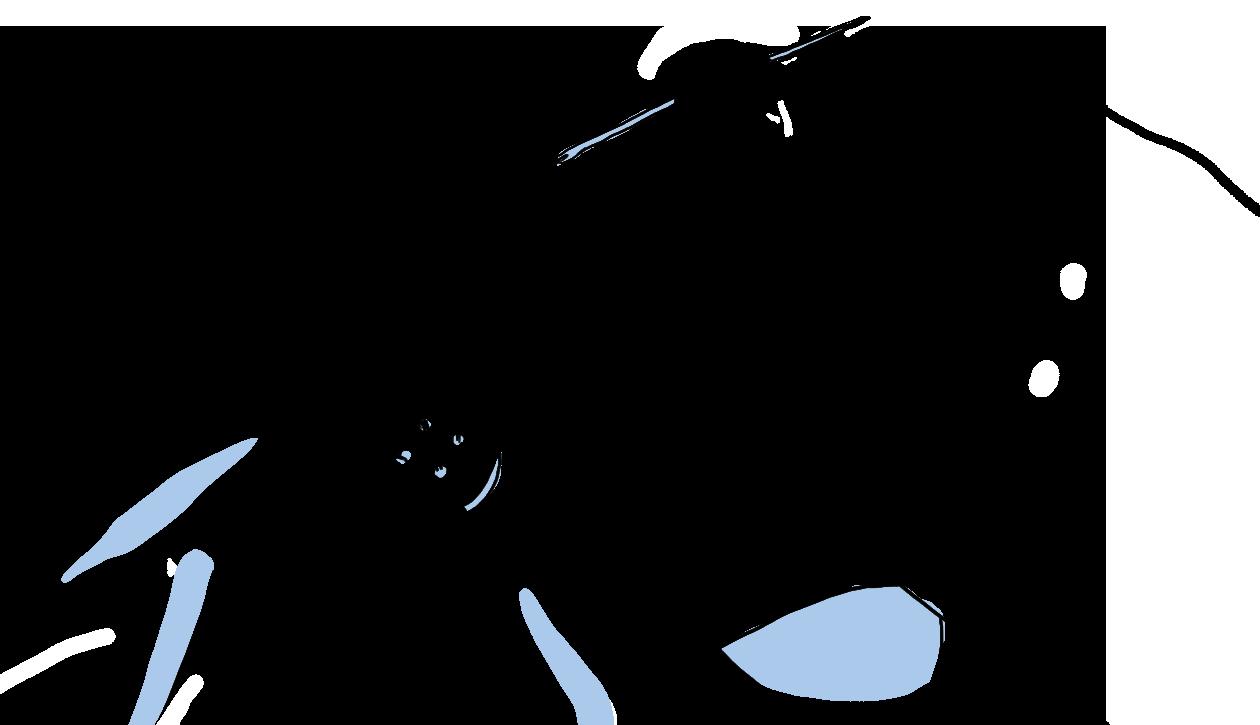
Step 4: Now, insert the needle through the back side of the cloth into the same hole you started with and repeat step 3 to secure the button in place. Your carbon atom is now in place.

Step 5: Secure four 1-holed buttons around the carbon button to represent the hydrogen atoms by following the same steps.
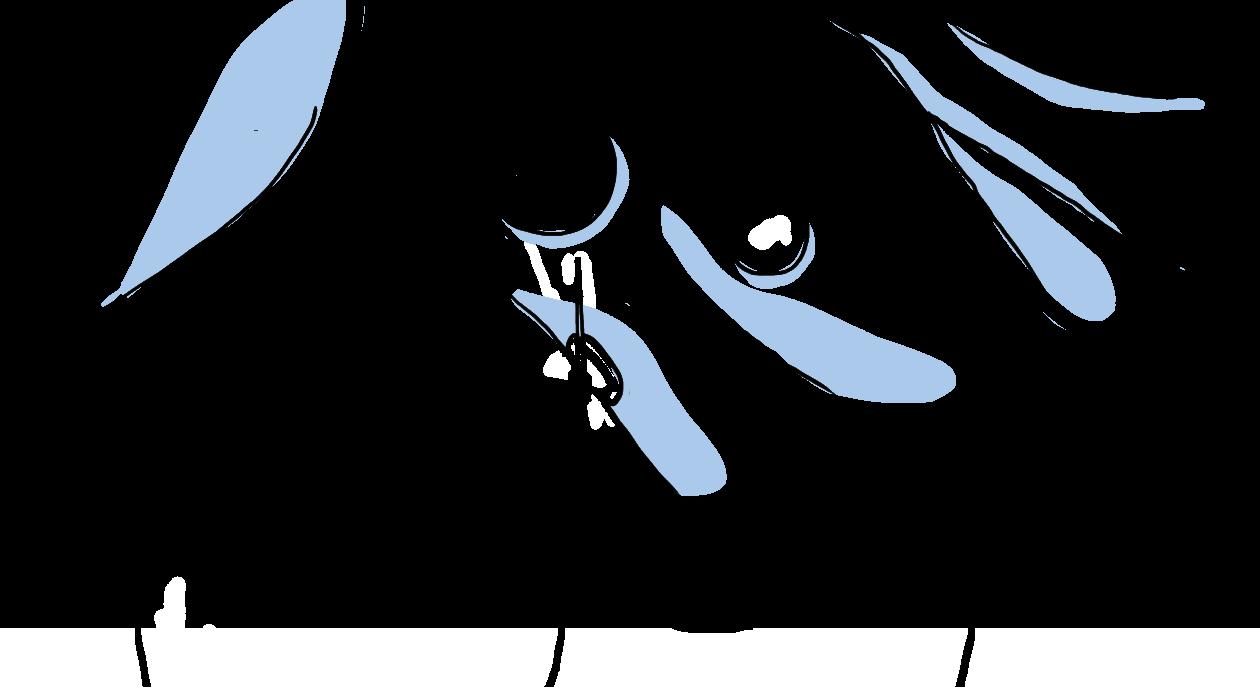
11
MAKING YOUR FIRST BOND:
Step 6: From underneath the cloth, bring the threaded needle out from right next to the carbon button.
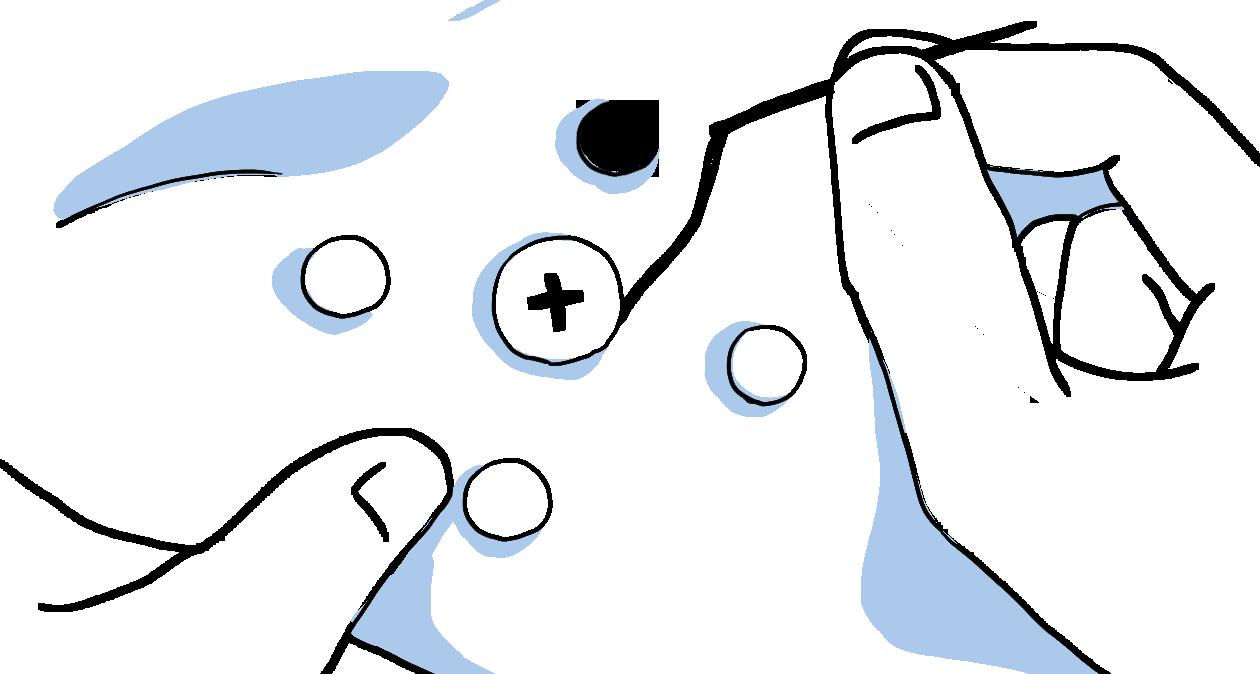
Step 7: Take the thread over to one of the hydrogen buttons and pass it through the cloth right next to the button. This is your bond!
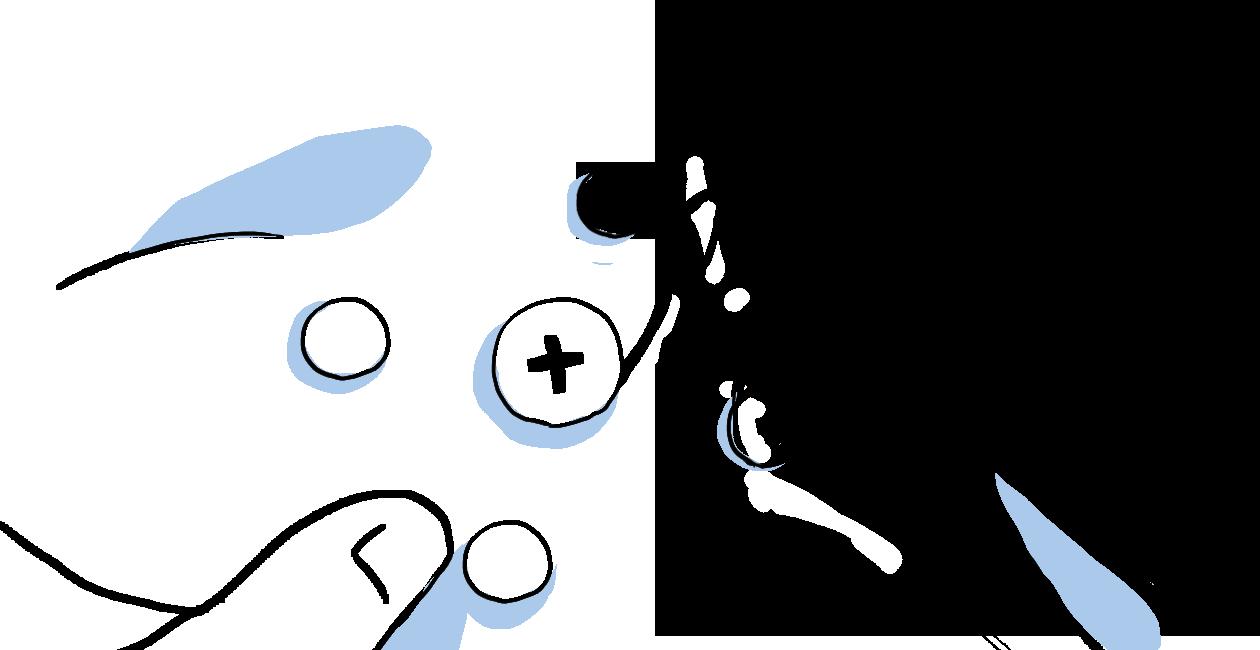
Step 8: Make your bond more visible by taking your needle back out from next to the hydrogen button, along the bond and back next to the carbon atom.
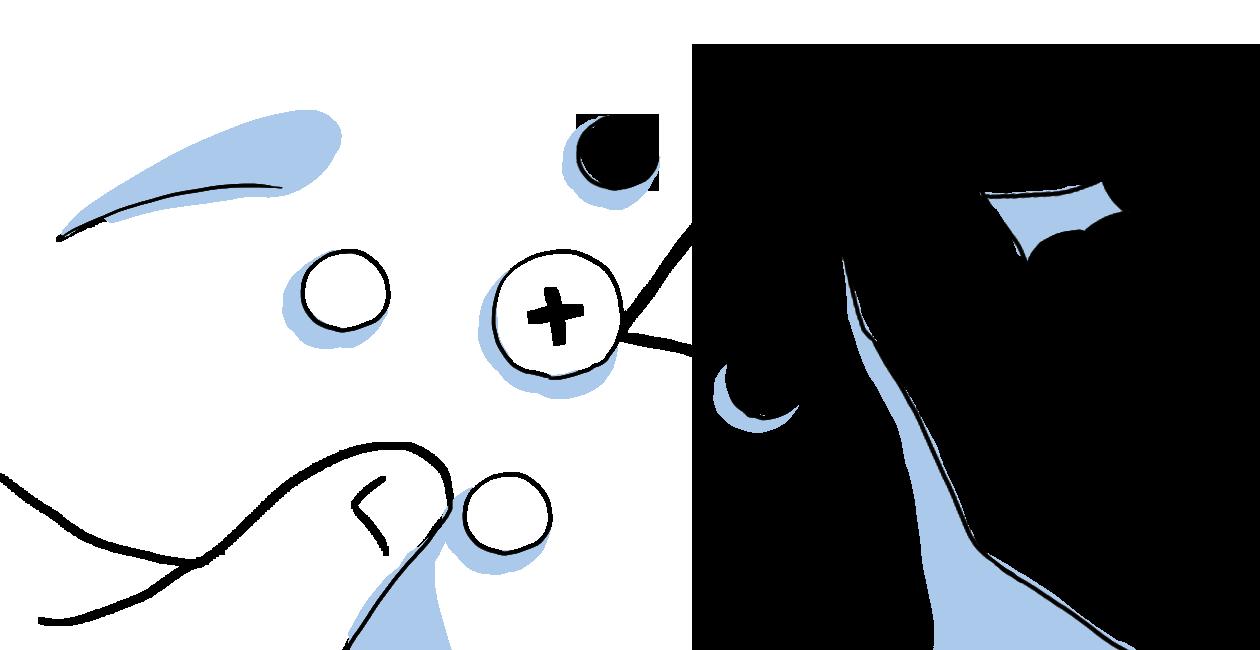
CARBON | 2023 12
Step 9: Your Carbon-Hydrogen bond is ready! Repeat the above steps to create the entire molecule.

REFLECT:
1. Draw the line diagram of any molecule with atoms of valency 4, 2 and 1 and create your own element embroidery! Some examples are given here:

2. Scatter a few 4-hole buttons on a piece of cloth randomly and try to connect them to each other, following the rules of valency. Do you think such unstructured forms of carbon could exist in nature? If so, how are they different from the structured forms of carbon that you created here?
13
Pentane
Glucose
Aspirin

CARBON | 2023 14
LET’S GET FIZZY!
Have you ever found yourself eating a spicy meal and then suddenly craving a sweet fizzy drink? Or have you craved a chilled lemon soda on a hot summer day? Fizzy drinks are a favourite across age groups and around the world. While these drinks come in a variety of flavours, they are always characterised by a signature bubbly, and almost sharp, texture. In fact, if you gulp down a lot of soda too fast, you get an almost painful sensation. Scientists have found that soda activates our pain receptors, and that is part of the reason we enjoy drinking it, just in the same way we experience the thrill of spicy food.8
Carbon is at the centre of the fizzy drink experience. These ‘carbonated’ drinks get their name from the bubbles in the soda, which are carbon dioxide. When carbon dioxide is dissolved in water, it does not mix in completely, and it separates into gas which is released as bubbles.9 While carbonation at an industrial level is done through pumping carbon dioxide into water at high pressure, natural carbonation processes have a long history of use in culinary cultures.
Alcoholic fizzy drinks like beer have been around for a long time, but the non-alcoholic genre emerged only around the late 1700s. India has had its own share of local fizzy drinks.10 However, as drinks from global bottling companies fill the markets, local brands are disappearing. It is possible to almost trace the history of our country’s shifting economic policies through the changing stock of sodas on store shelves over the decades.
Let’s explore the science and history of fizzy drinks by creating our very own. Fuljar soda is a street-style fizzy drink, known to have originated in Kerala, which is popular for its unique style of preparation.

8 Wang, Chang and Liman, 2010.
9 Baguley and McDonald, 2015.
10 Gangopadhyay, 2023.
15
PREPRATION TIME: 5-7 minutes
INGREDIENTS: (for one serving)
500-700mL Club soda
1 inch Ginger
1 tbsp Lemon juice
1/4 tbsp Chaat masala
1 Green chilli (adjust the quantity according to your preference)
8-10 Mint leaves
1/2 tsp Sugar
2 pinches of Black salt/rock salt
OTHER ITEMS:
Mortar and pestle or mixer
1 shot glass
1 big glass
PROTOCOL:
Step 1: Prepare the shot
Add mint leaves, lime juice, sugar, chaat masala, black salt, green chilli and ginger to a mortar. Use a pestle to grind the ingredients. Once they form a smooth paste, transfer it to the shot glass. You can also use a mixer grinder for this process.
Step 2: Get the soda ready
Fill your bigger glass halfway or 3/4th with club soda. Make sure you leave out some space in the glass, as the soda will fizz up.
Step 3: Let the fizzing begin!
Be sure to do this part in an open area as it is bound to get a bit messy. Drop the prepared shot into the big glass of soda and drink quickly as it starts to fizz up. The bubbles will rise instantly as you drop the glass and might even spill out of the glass.Your Fuljar soda is ready!

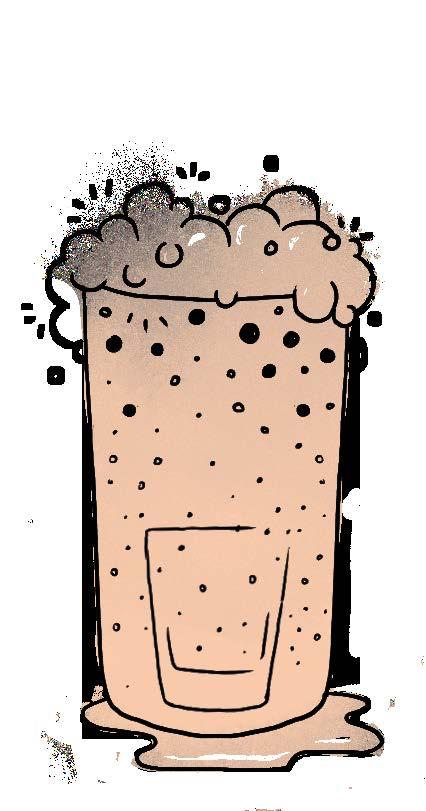
The fizzing works on the same principle as the popular mentos-cola experiment. Dropping a porous and rough surface like mentos into a carbonated beverage causes the already weak bonds between the dissolved carbon dioxide and water molecules to break, and leads to the fast release of the carbon dioxide gas, resulting in bubbles or even a volcano-like eruption.
Let’s do a simple activity that demonstrates the same, where you can use different objects around you instead of mentos and drop it into any fizzy drink of your choice. 16
CARBON | 2023
Step 1
Here’s a video to help you through the process.
Step 2
Step 3
Is your fizz out of control?
List the objects that you drop
Stone
Marble Salt Raisins
REFLECT:
Did it fizz up like a volcano?
Did it simply cause more bubbles to form?
space to note your observations
Why did some objects result in a simple bubble formation while some fizzed up like a volcano? Do you think this changes with different types of fizzy drinks? Explore!
1. Fuljar soda has spread all over Kerala as a refreshing, summer drink. Are there similar local fizzy drinks in your area? Look for them in your local store or juice shop!
2. Are there packaged fizzy drinks produced within India? If so, find out if these brands are available only in a localised region or available across the nation? Based on your research, what effects (if any) do you think large, global bottling companies have on local food and drinks?
17

CARBON | 2023 18
TURN OVER A NEW LEAF
One of the things we learn quite early into our time at school is the importance of trees. By taking in carbon dioxide (CO2) and giving out oxygen via photosynthesis, they regulate the composition of the atmosphere and make it hospitable for humans to live in. They provide us with food and other raw materials. Our very survival is dependent on the ecosystem services provided by trees, and the rest of the natural world. Disrupting these environments is equivalent to cutting off our own lifeline. As the climate crisis progresses and affects life and livelihood, the conversation around conservation is gaining a sense of urgency.
While understanding the necessity of natural resources for our survival is important, some dimensions of the conservation discourse urge one to value the natural world in and of itself.11 While we have read a lot about trees in textbooks, we have also experienced them. Perhaps we have climbed their branches, played with fallen leaves and fruit, or rested in their shade. Maybe we have gathered around them for community meetings and discussions. From being sacred landmarks to ornamental entities in the urban fabric, it is not surprising that trees have also inspired art and can be found at the centre of many stories, songs, and paintings.
From the heart and from the head—let us explore different ways of looking at trees! In the first part of the activity we will approximate the amount of carbon stored in trees and learn about the role of trees as carbon sinks. In the second part, we will get a bit closer and observe the small details around trees that may seem stationary, but are actually buzzing with activity. And maybe, we will let them inspire some poetry.

19
11 Greta, 2023.
MATERIALS REQUIRED:
1. Measuring tape
2. Notebook and pen to note down your readings
3. Calculator
4. A few trees!
You can refer to this link to see how to measure a tree
PROTOCOL:
1. Identify a tree around you.
2. Measure the diameter (D) of the tree in inches.
3. Measure the height (H) of the tree in feet.
Diameter (D): inches
Height (H): feet
To measure height (H) of tree: There are different methods to measure the height of a tree. An easy way is to hold out your thumb in front of you, close one eye and align your hand with the base of the tree.
Walk backwards until the tip of your thumb also aligns with the top of the tree. Now rotate your thumb by 90º and ask a friend to mark the point that it indicates to, on the ground to the side of the tree.
Ask a friend to measure the distance from the middle of the tree’s base to this point. This measurement is roughly equivalent to the height of the tree.
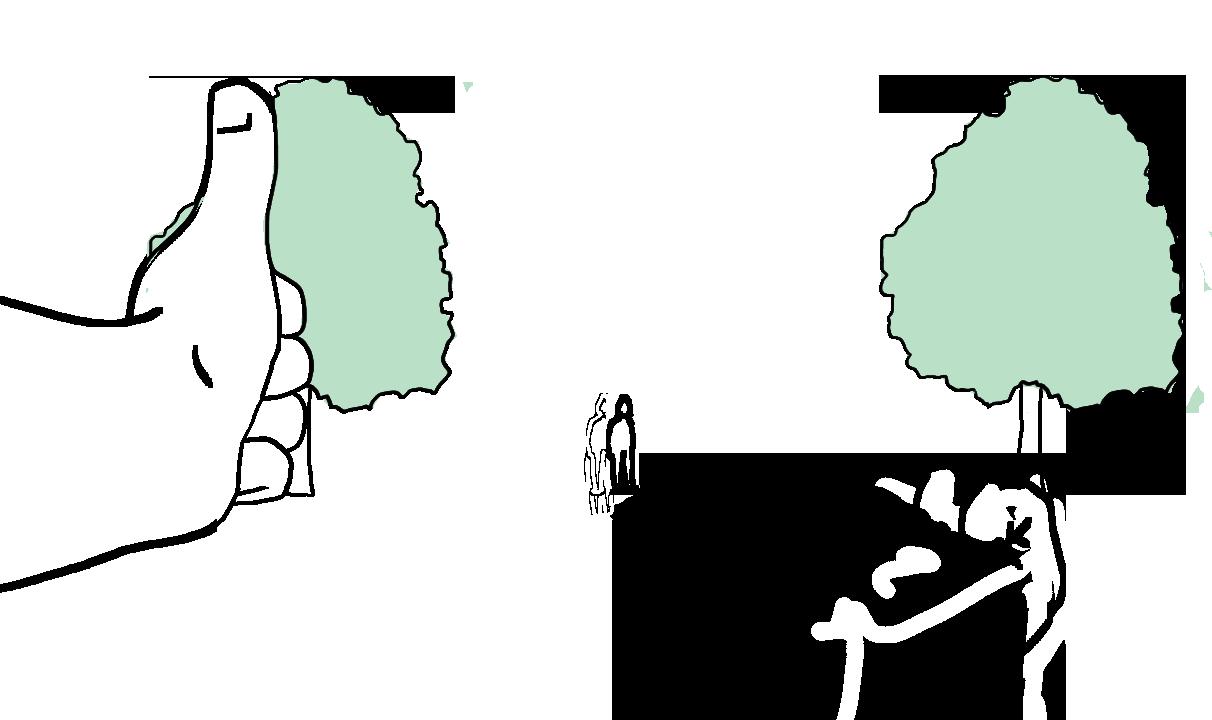
CARBON | 2023
20
CALCULATIONS:
Calculate the following, and note them down below:
A. The total green weight of the tree
B. The dry weight of the tree
C. The weight of the carbon in the tree
A. CALCULATE THE TOTAL GREEN WEIGHT OF THE TREE
Determine the green weight (or the tree’s weight when it is alive) of the tree above the ground. Use the following formulae, where D is in inches and H is in feet:
For trees with D<11 : Wabove ground = 0.11 x D2 x H
For trees with D>11 : Wabove ground = 0.07 x D2 x H
Wabove ground = _________________ kg
Since the roots of a tree are approximately 20% of the tree’s weight above ground, you get the total green weight of the tree by multiplying 1.2 with its above ground weight. The formula is:
Wtotal green weight = 1.2 x Wabove ground
Wtotal green weight = ______________ kg
The calculations are done based on the assumption that trees are roughly cylindrical.
21
B. CALCULATE THE DRY WEIGHT OF THE TREE
Since the average tree is 72.5% dry matter and 27.5% moisture,
Wdry weight = 0.725 x Wtotal green weight
Wdry weight = ______________ kg
C. CALCULATE THE WEIGHT OF THE CARBON IN THE TREE
The carbon content of a tree is approximately 50% of the tree’s total dry weight.
Wcarbon = 0.5 x Wdry weight
Wcarbon = ______________ kg
CARBON | 2023 22
Repeat the exercise for two or more trees of different species and note your calculations in the table below:
Trees Carbon sequestered in trees (in kg)
Do you think the carbon sequestered by different species of trees is the same?
23
for
space
calculations
Trees are not just crucial carbon sinks, they also play a central role in providing sustenance and resources to the organisms around them. It is important to recognize the intricate interactions and smaller details that contribute to their dynamic nature, which often go overlooked.
BINGO!
Observe a tree in your locality and its immediate surroundings. Strike the things you see from the Bingo card given below. The goal is to hit BINGO by striking out any 5 in a row or column.
B I N G O
Another tree of the same species nearby
Mushrooms
Leaf litter underneath
Squirrels
Fallen seeds or seed-pods
Ants
Spider webs Flowers
Large canopy providing shade
Flying insects
Fruits Moss / Lichen Grass
Tree bark peeling off
Carvings on the tree bark
Humans (other than youself)
Can hug the entire tree trunk
Crawling creatures
Visible roots Bird Nest
Termites Tree Sap
Beehive
Non-green leaves
Presence of water
CARBON | 2023 24
space to write your poem
REFLECT:
1. Based on the BINGO, write a poem about your tree. How would it be experiencing the world around it?
2. Are trees shy? When you look up at tree tops, you may observe that the tree crowns form an intricate pattern of gaps almost like they’re avoiding each other! This phenomenon is called Crown Shyness. Why do you think trees display this?
25
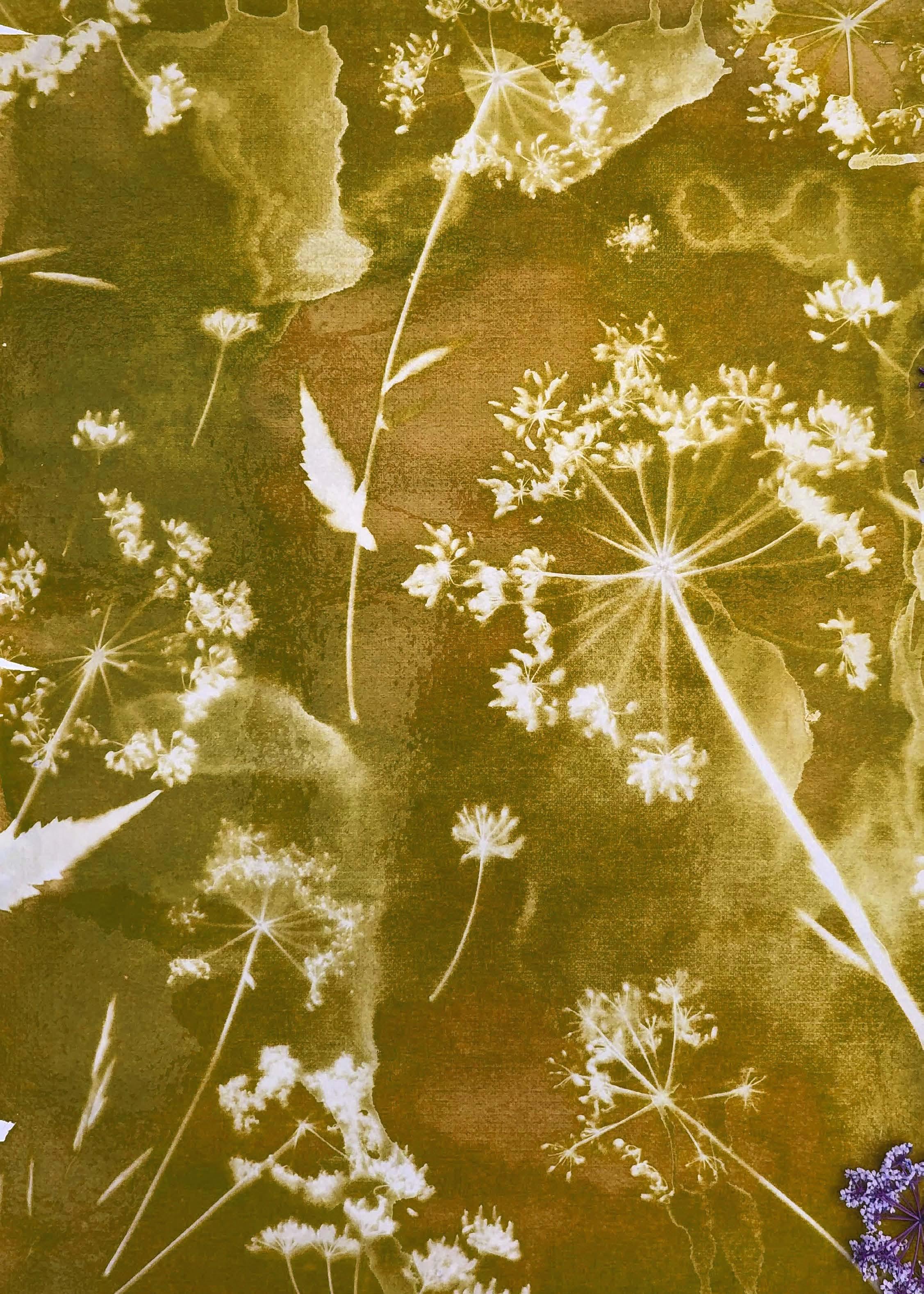
CARBON | 2023 26
CURCUMIN CLICKS
Say cheeeeese! Click click click. In today’s age taking a photo is a simple affair. We walk around with camera equipped devices in our pockets. Be it pretty sunsets, yummy food, or just our own faces, we can capture life around us in a flash. It was not always like this, of course! Camera technology has been developing over the ages. The earliest camera, named camera obscura, was only capable of projecting the image of an object on a surface, which could then be traced.
It was only about 200 years ago, however, that the first photograph was taken. Carbon found its way into this picture. The photograph was taken by Joseph Niépce, when he exposed the light from a window through a camera obscura and onto a plate coated with a light-sensitive, carbon based material called bitumen of Judea. After eight hours of exposure, the plate was washed with petrol and lavender oil to reveal an image of the landscape visible from the window.12
Even as the technology expanded in different directions and materials, from silver salts to digital cameras, carbon was still used in the art of photography. Carbon prints remain popular for their level of detail and longevity over other silver salt based images.13 Around the same time that Niépce was using bitumen for photos, plant extracts were also being used in photography. Thus was born the anthotype, a method in which light-sensitive plant based pigments, often carbon-containing molecules, were used to develop prints. Anthotypes have been developed as a branch of alternative photography.14
In this activity, we explore the fundamentals of photography by making our own anthotypes. For this, we can use a plant pigment perhaps already present in our kitchens—turmeric! The signature bright yellow colour in turmeric comes from a carbon based, light sensitive molecule called curcumin15. Let’s make our own photos by using sunlight and curcumin!

12 Brown, 2002.
13 Helion, Walker and McCade n.d.
14 Fabbri 2021.
15 PubChem, 2004.
27
YOU WILL NEED:
Turmeric powder
Alcohol (rubbing alcohol/vodka/ hand sanitizer)
2 small glass containers
Spoon
Cotton cloth/tissue paper
Paint brush
Inkjet paper/watercolour paper
Baking powder/borax
A broad tub
A plant leaf!
Sunlight
Be careful. Turmeric will stain hands, clothes and surfaces yellow!
PROTOCOL :
Step 1: Mix 1–2 spoons of turmeric with 4–6 spoons of alcohol in a glass jar to make a paste. Make sure the mixture is not very grainy. Curcumin—the molecule responsible for the yellow colour of turmeric—dissolves well in alcohol.

Step 2: Now, filter the mixture by passing it through a cotton cloth placed over a glass container. Make sure no grainy particles pass through. Squeeze out any remaining liquid from the cloth into the glass container.

CARBON | 2023
28
Step 3: Your dye is ready! Use a paintbrush to paint over the paper with the dye.
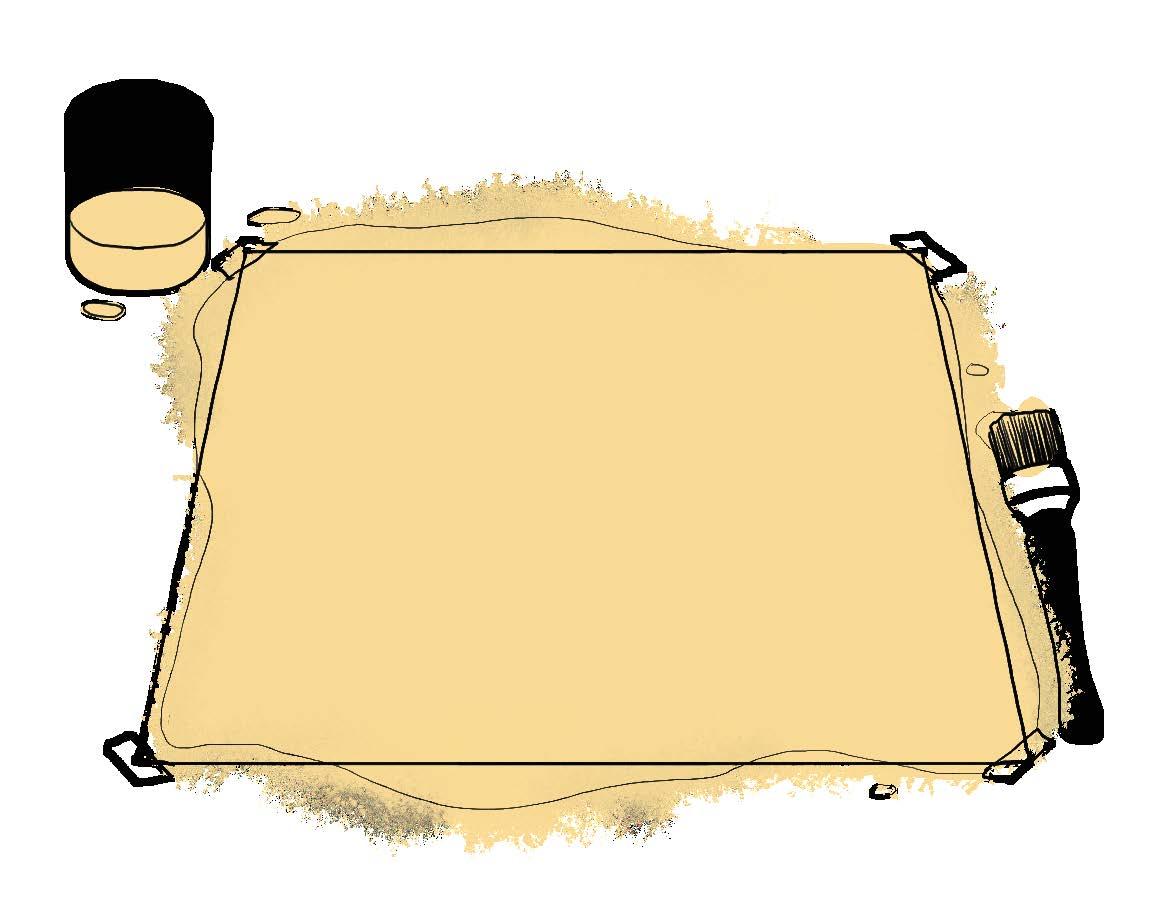
Step 4: Place the leaf over the painted paper and leave it out in direct sunlight. If you are lucky and it’s a sunny day, you can leave it out for 4–5 hours. Else, you can leave it out for an entire day.

You would notice that the yellow colour fades slightly. If it doesn’t, you can always leave it out in the sun for longer.
29
Step 5: Peel the leaf off. You will notice that the area covered by the leaf is bright yellow.
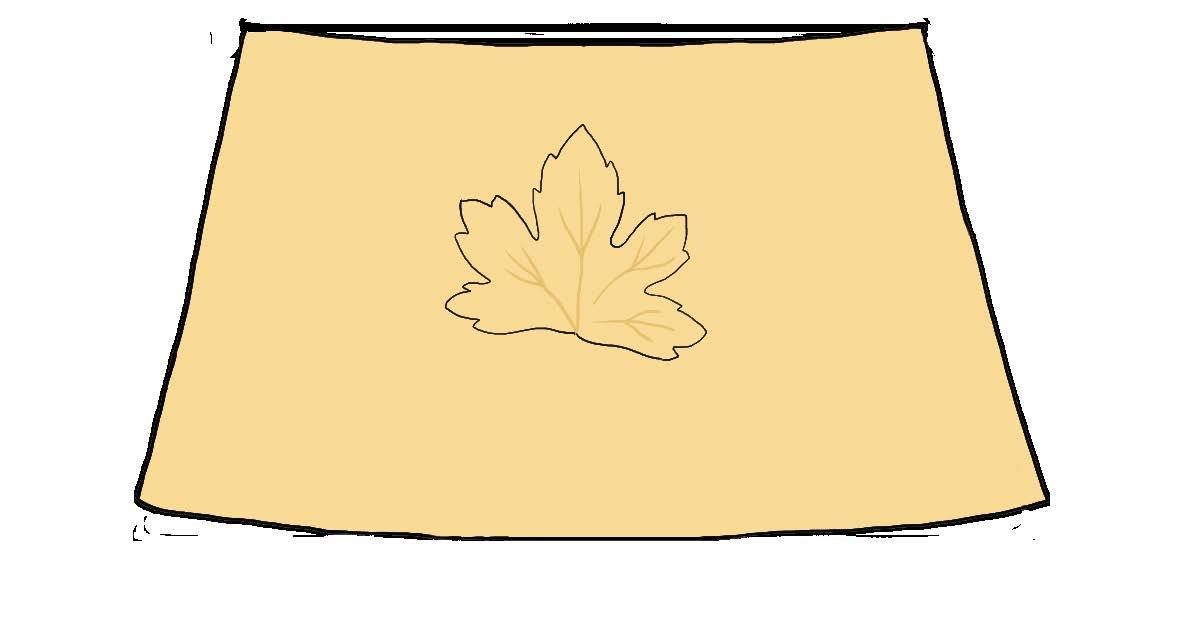
Step 6: Now, mix 2 spoons of baking powder in lukewarm water. This solution will enhance the curcumin.
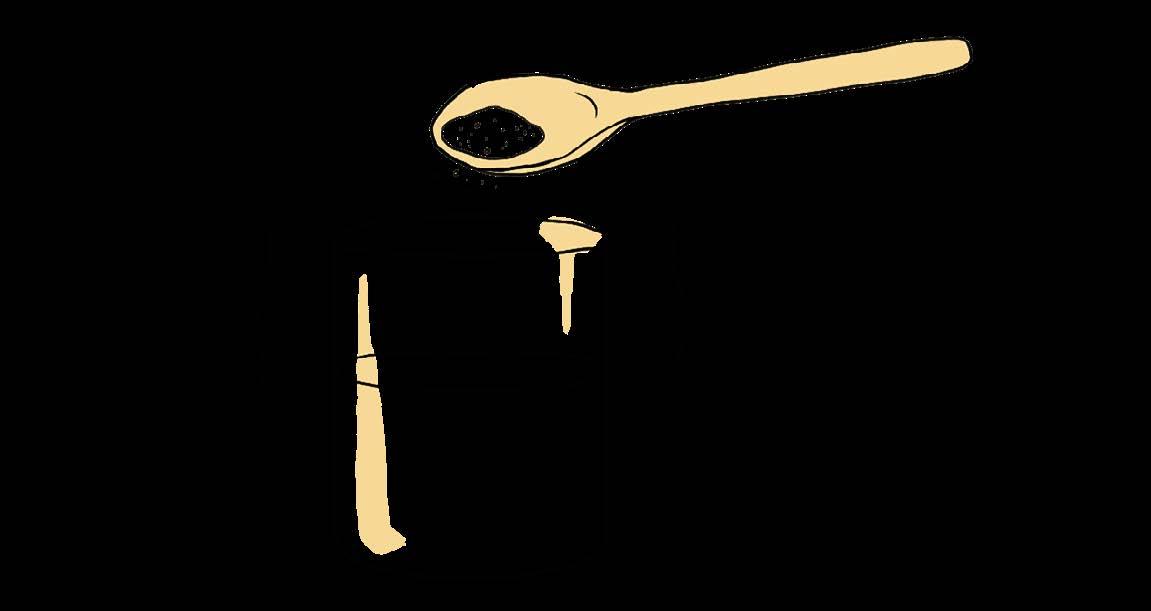
Step 7: Finally to develop your anthotype, place the paper in the tub and pour the baking powder solution on it slowly.
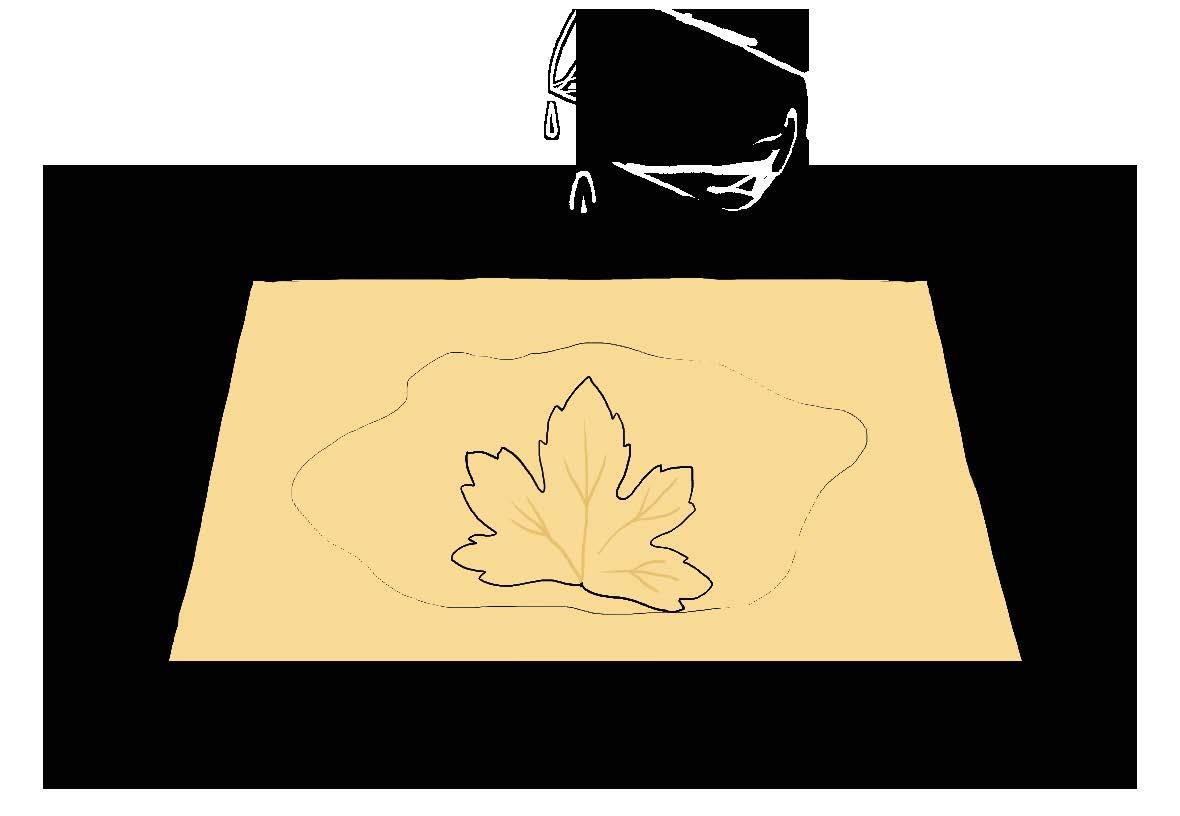
CARBON | 2023 30
Step 8: Take the paper out and let it dry in a dark place. Your anthotype photograph is ready!

You can try using different kinds of leaves, flowers or grass to create anthotypes with a variety of patterns!
REFLECT:
1. Can you think of other flower/fruit extracts from which you could create similar anthotypes?
2. Ever CC’ed someone in a mail? CC stands for Carbon Copy. Before the advent of photocopiers, carbon paper was used to copy written documents onto another paper by placing the carbon paper underneath. Look for carbon papers in your nearest stationary store to understand how the process works!
31
to doodle
space

CARBON | 2023 32
DEAR (DIGITAL) DIARY,
The footprints we make on a sandy beach get wiped away by the water and wind. On the shores of the computational seas however, there are no natural elements to erase our traces. As digitization and internet usage grow at a rapid pace, they bring with them a looming issue—digital carbon footprint. It is defined as the carbon dioxide emissions generated during the production, use, maintenance and disposal of a digital device.16 While it is easy to imagine the environmental impact of a device’s manufacture, maintenance and disposal, the impact of internet use is not as intuitive. Activities such as sending a text, liking a post on social media, or visiting a website seem like they happen almost magically. The carbon cost of these activities are hidden away from the consumer. But behind clicks and likes are data centres and transmission networks. It was found that the internet consumes 416.2 terawatt hours of energy per year.17 That is almost seven times the annual energy consumption of Karnataka.18
That being said, it is difficult to live without the internet today. We rely on it to find directions to a place, discover new research, or even video call a loved one. The very same network that is contributing to the ongoing climate crisis also helps us learn more about how we can potentially prevent it, or creates a space to express our fear about it. How do we navigate the complexities of the internet in the context of climate change? Perhaps we can begin by being more aware. Seemingly seamless streaming takes place at such speeds that it is easy to lose track of how much time we spend online. And the invisibility of wires and waves make us disconnected from the internet providers that keep us connected. In this activity, let’s take a moment to look at the internet—how much we use, how we use it, and how it works.

16 Sharma and Dash, 2022
17 Bawden, 2016.
18 CEIC, 2023.
33
Assign a colour to your activity’s polygon below and use it to fill and record your digital activities in a day.
CARBON | 2023 34
AM 12 6 3 9
Gaming Streaming Movies Video Call Streaming Music
Can you think of more digital activities that you can track?
Uploading a HD Photo
Sending an Email Website Browsing Text Messages
35
PM 12 6 3 9
19 Griffiths 2020.
20
21 Worldfavor, n.d.
22 Google Sustainability, 2023.
DIGITAL ACTIVITIES TRACKING:
Now that you have tracked your digital activities, let us unravel their impact on the climate.
Sending a single email emits around 4 grams (g) of carbon dioxide equivalent (CO2e). A text on Whatsapp or Facebook messenger is just a little less than that. Add in a picture attachment, and this number goes up to 50g CO2e. By itself, this is more climate friendly than sending a physical letter. However, we collectively send an enormous number of emails and texts—the world’s yearly email usage produces CO2 equivalent to if there were 7 million additional cars on the roads. If every adult in the United Kingdom cut down the number of ‘thank you’ emails sent, it would save 16,433 tonnes of carbon emissions a year.19
There are other examples as well. For instance, video calling tends to be a lot more energy intensive than voice calling. Researchers at Purdue University recently calculated that if one turns off their video in conference calls in a week of 15 hours worth of meetings, it would reduce carbon emissions by 9 kilograms.20 That is equivalent to three years worth of charging a smartphone at night. Video streaming also tends to be greatly energy intensive. Using a streaming service for an hour or two for an entire year requires the same amount of energy that is required to power a refrigerator for half of that year.21
While this is a useful exercise to learn about your own digital activities, the contribution of individual actions is still a fraction to that of larger corporations and industries. In its yearly environmental report, Google put its energy usage for 2022 at 22.28 TWh, which would be equivalent to powering an air conditioner 24x7 for 847 years.22 It is difficult to navigate a world where the systems in place leave one with no option but to contribute to global emissions in order to participate in the status quo. Where does the real responsibility lie? With the consumers, producers, or both?
CARBON | 2023 36
High Carbon Footprint
Low Carbon Footprint
Obringer et al. 2021.
space to write or doodle your thoughts
Digital activities do have a high carbon footprint, but unfortunately are not easy to avoid in today’s world. From your digital tracker, what activities do you feel are possible to cut down on? What are some alternative activities that can meet the same purpose but have a lower carbon footprint?
REFLECT:
1. What steps can be taken to make a website more sustainable?
Check the carbon footprint of different websites by using this online tool: https://www.websitecarbon.com/
2. Should you make the switch? Digital note-taking is gaining popularity over traditional pen and paper. Based on raw materials, production and energy consumption considerations, which do you think is more sustainable in the long-run? How would you go about researching this question?
37

CARBON | 2023 38
FUEL FOR THOUGHT
There are no two ways about it: the mining and use of fossil fuels like coal and oil in industry and transport have transformed the way we live. Air conditioners to cool our surroundings, industries to process and package food, and vehicles to carry us over distances. In 2022, fossil fuels accounted for 77% of India’s total electricity generation.23
The growth of cities and industries above the ground has been fueled by the wealth that exists beneath it. In the thrill of rapid growth, we operate our economic systems as though we have infinite resources. However, as production and consumption rise, resources begin to deplete, and we dig deeper and deeper to find them.
Unlike a car which gives a sustained output of energy until the last drop of oil in its tank, resource extraction is found to increase rapidly at first, before coming to a peak and then declining to form a bell curve known as the Hubbert curve, named after the American geologist M. King Hubbert.24 The tip of this curve is called peak oil—the point at which oil extraction in a location is at its pinnacle, after which it goes downhill.
Resource decline poses imminent threats of geopolitical tensions and economic stress. Though we may not be able to accurately guess when the peak will come, it is certain that there are finite resources on this planet, and the effects of burning fossil fuels are already visible. How will we use the oil that remains? Can we even afford to emit more greenhouse gases? And what would life look like if we stopped using fossil fuels?

39
23 Kemp and Kemp, 2023.
24 Stuart McMillen, 2015.
MATERIALS REQUIRED:
1. A large tub (approximate dimensions: 30cmx30cmx15cm or roughly the size of a shoebox)
2. Sand or rice: enough to fill the large tub
3. Beans: around 100 grams
4. Timer/stopwatch
5. 2 plates: one to collect your resources, one to discard them
6. Graph paper or a plotting software
7. 3 more friends!
PROTOCOL:
This activity helps you experience the extraction patterns of limited, non-renewable resources.
1. Laying the groundwork:
Take the large tub and fill it with sand or rice, leaving a 5–6 cm gap.Now distribute the beans inside it and mix them well so that some beans are buried and some are visible.
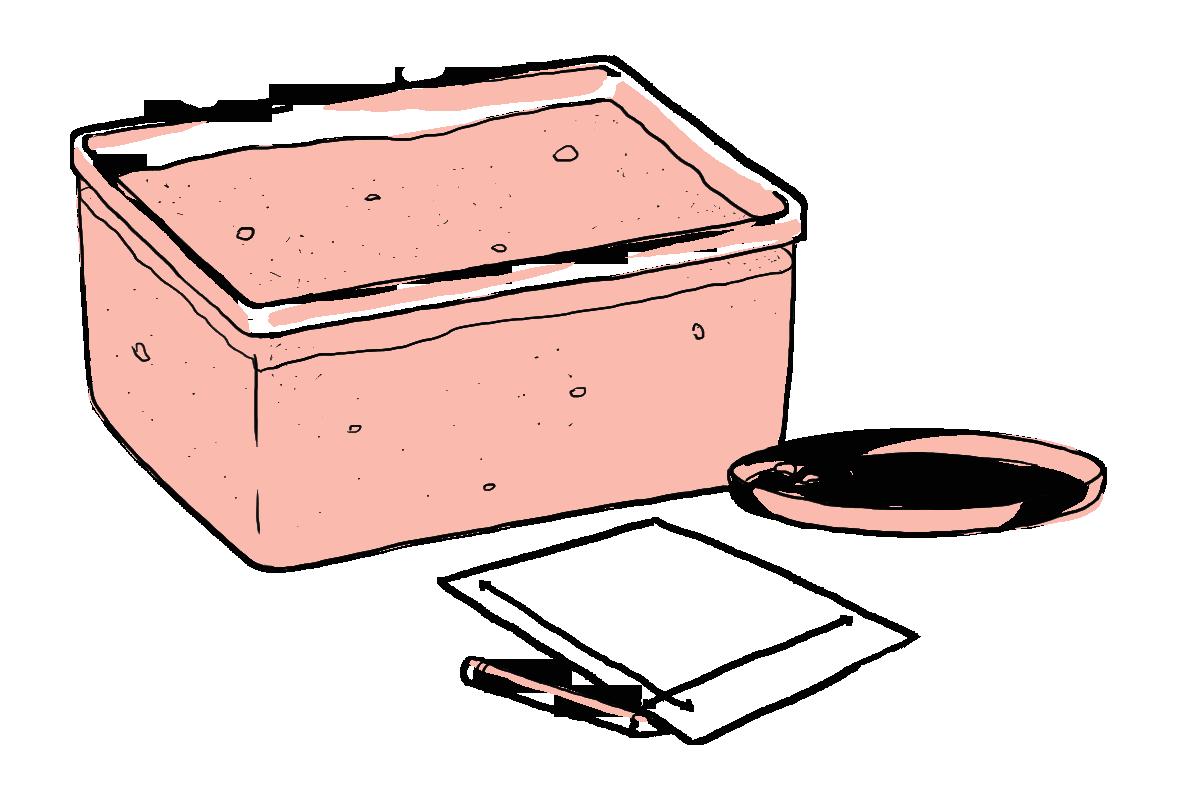
2. Rules:
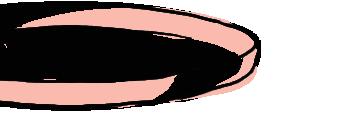
• The objective of the activity is to step into the shoes of mineworkers and recover as many resources (beans) as possible in each ‘working day’ while ensuring the sand/ rice stays in the mine (i.e., the tub).
• You must mine within a set ‘working day’ defined as 30 seconds. One person can keep track of the time and indicate when to start and stop.
• You are allowed to mine only with your thumb and index finger, and pick up only one ‘bean’ at a time and place them in the collector plate.
• Count the number of beans in the collector plate and note the data in the data sheet on the next page. After recording the data, move the beans to the ‘discarded’ plate. Once resources are extracted, they cannot be returned to the mine. The discarded plate will contain resources extracted on all the previous days.
CARBON | 2023 40
• For the first ‘working day’, only one person mines for the resource.
• For the second ‘working day’, one more person joins and so two people will be mining for resources.
• For the third ‘working day’, another person joins and so three people will be mining for resources. This resembles the real-life scenario where more and more companies join the extraction after a resource well has been discovered.
• Continue with the 30-second ‘working day’ and note down the data for each ‘working day’.
• You may notice that after a point, it becomes increasingly difficult to find beans. Keep noting down data until you’ve run out of beans.
• While you’re carrying out the activity, note down your thoughts and feelings in the space provided below. What are some of the phrases that came up during the activity? space
41
to write your thoughts
CARBON | 2023 42
Working Day
Number of beans collected
Use the data you’ve collected and graph it using any plotting software or on a graph paper.
What does the graph look like? Does it bear any resemblance to the graph (Bell curve) below?
REFLECT:
1. Every country follows its own Hubbert Curve based on the availability of resources and technological advancements in that area. Where do you think India lies on the Hubbert Curve? Have we reached our ‘Peak Oil’?
2. Around 2010, the US Peak Oil curve showed deviation from that predicted by Hubbert’s theory wherein the curve started rising once again. What do you think could be the reason this trend was observed?
43
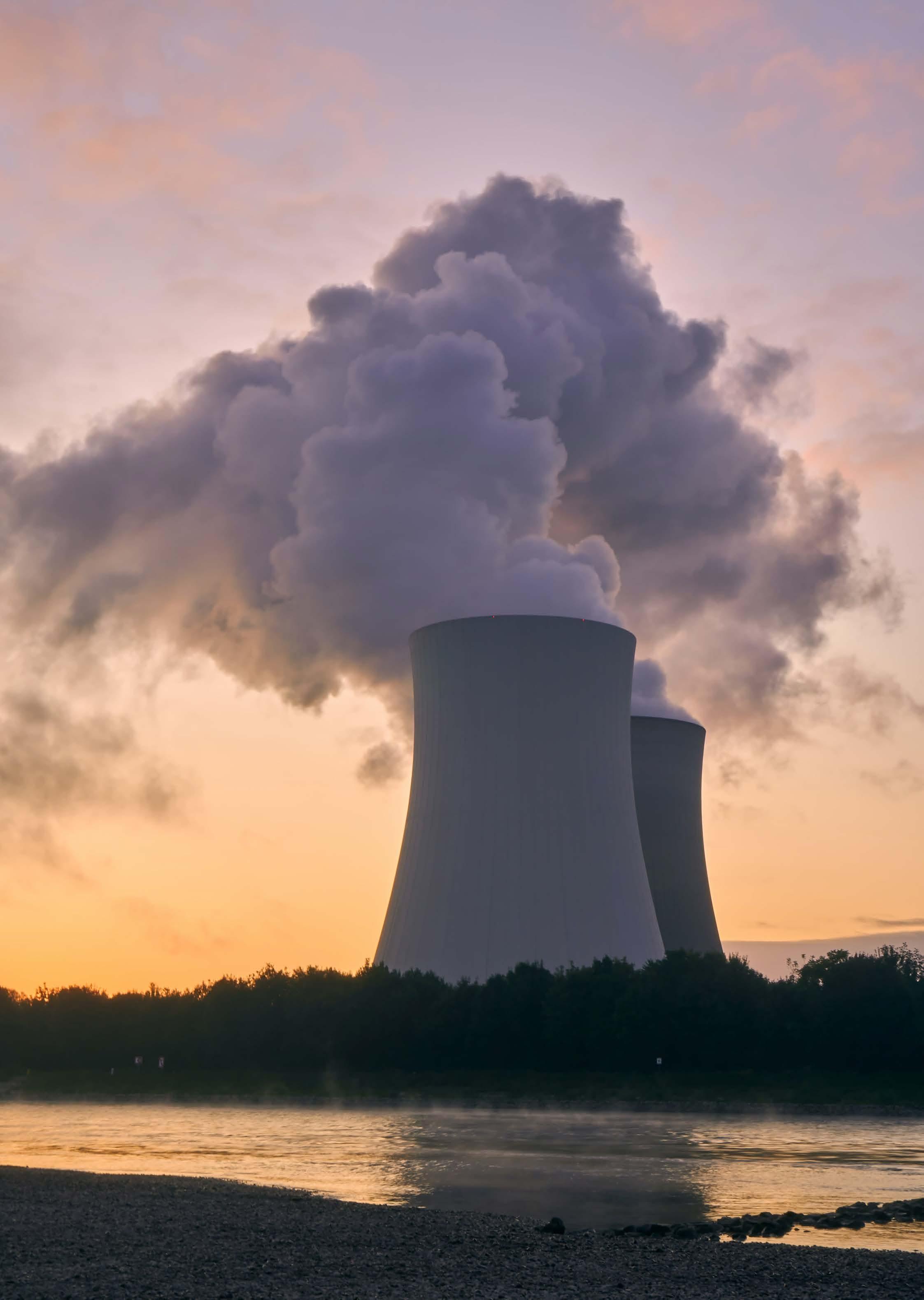
CARBON | 2023 44
A FOOTE-NOTE IN CLIMATE HISTORY
Human driven climate change is a subject currently under discussion and study. Across the world, there is a collective push for governments, industries, and individuals to take steps to mitigate the effects of climate change on human life and livelihood. In 1972, the United Nation (UN) held its first conference on environmental matters—the First Earth Summit.25 At this meeting, the UN raised the issue of climate change for the first time, and recommended that governments make policies that restrict greenhouse gas emissions and use of other pollutants.
However, one of the first warnings came more than 100 years ago—back in 1856 in a paper published by the scientist Eunice Newton Foote. She wrote about the change in temperature in tubes of different gases on exposure to sunlight. The most prominent of her findings was that tubes with water vapour and CO2 respectively, retained a lot of heat. In her paper, she wrote: “An atmosphere of that gas would give to our earth a high temperature”, and thereby foreshadowed the ongoing climate crisis, wherein rising atmospheric CO2 levels is of great concern. Eunice Foote was not only the first to forewarn about the greenhouse effect but also the first published American female physicist.26
What would have happened if we had acted upon early warnings put forth by Foote and many others? Let’s reflect on the way climate history has unfolded, and honour the contributions of Eunice Foote through blackout poetry. This activity could serve as a metaphor for the warnings of climate change, as well as the voices of female scientists that have often gone unacknowledged.

26
45
25 United Nations, n.d.
Arnold, 1984.
MATERIALS REQUIRED:
All you need is a bold black pen or marker to black out text.
INSTRUCTIONS:
Redaction poetry or Blackout poetry is characterised by the use of a marker to redact or black out some words from an existing text, leaving the remaining words to read out sequentially like a poem. This kind of poetry is almost like an act of rebellion, in which a piece of writing is transformed to reveal new perspectives.
Eunice Foote’s paper “Circumstances affecting the heat of the sun’s rays” (1857) is reproduced in the next few pages. Use the research paper itself as the piece of existing text for your blackout poetry.
Below is an example of blackout poetry by Austin Kleon. Let your creative juices flow!
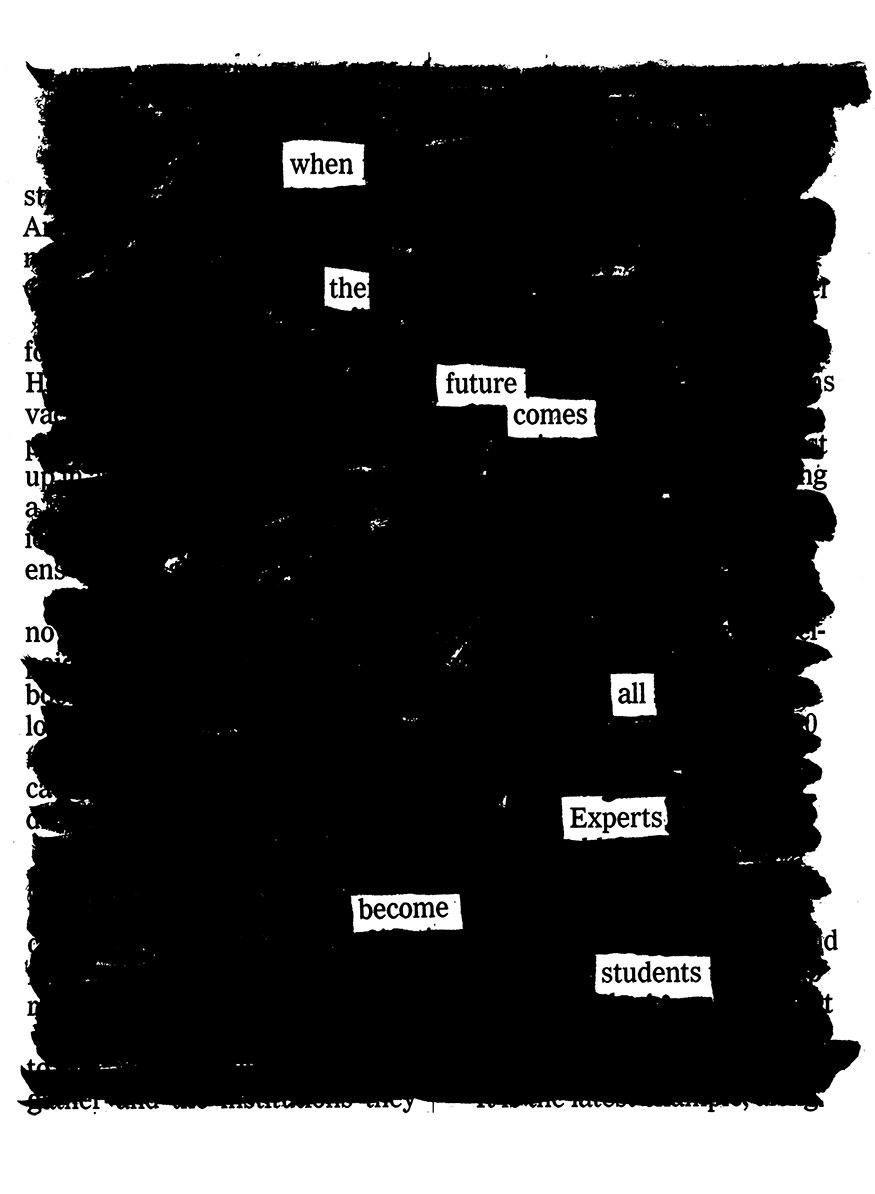
CARBON | 2023 46
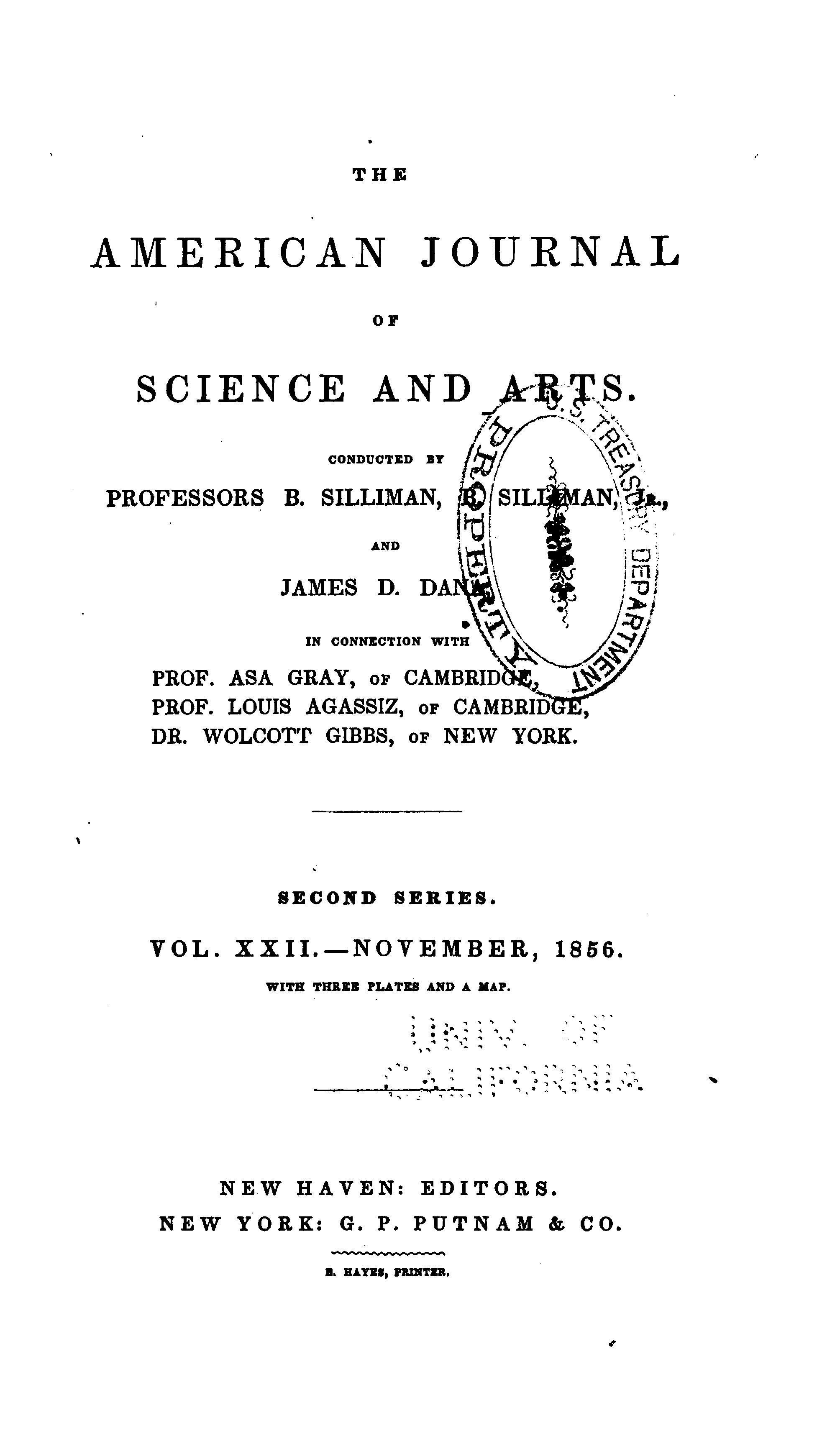
47

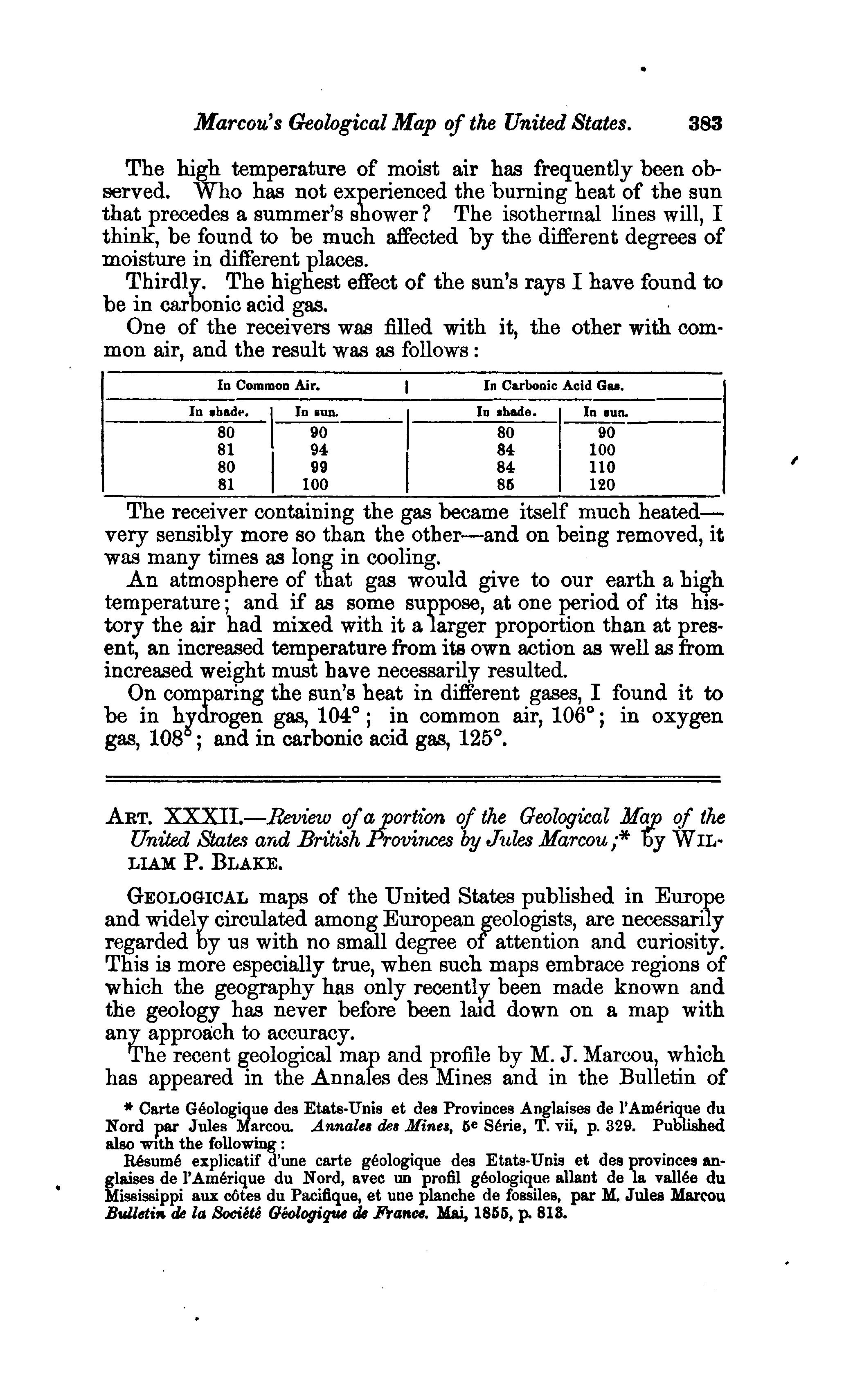
REFLECT:
1. Eunice Foote’s experiments were simple yet had far reaching consequences. You can recreate her experiments by following this procedure.
2. What is your climate story? All of us have different instances or experiences in our life when the effects of climate change really hit us. When was the first time that you noticed some effect of climate change?

CARBON | 2023 50
CHOREOGRAPHING CARBON
As the climate crisis worsens, its impacts are felt around the world. Environmental devastation, natural disasters, and biodiversity loss affect our present and future. The issues and causes seem so complex, with so many players involved, that individual efforts can feel futile. Even as the call for solutions grow louder and efforts are underway, CO2 emissions continue to rise globally.
Amidst all the disasters around us, we might feel helpless and hopeless. The feelings of climate grief and ecological anxiety are growing among young people. In a recent survey 40% of participants—all between the ages of 16–25, and of different nationalities—stated that they are hesitant to have children because of climate related anxiety.28
Expressing yourself through art and storytelling can be a powerful way to process and cope with these calamities. Singing, dancing together, writing poems or drawing a simple sketch, we turn to art for comfort in times of crisis.
In this activity, we will use dance and movement as a way to embody our stories. From bharatanatyam and kathak to hiphop and ballet, dance and movement have been used as forms of storytelling.
You do not have to be a dancer to participate in this activity! Our lives are filled with their own pedestrian movement. Through our daily activities, we all have intuitions to represent ideas and concepts through movement. Let us tap into this intuition to tell our own stories about carbon and the climate, in a collective setting.

51
28 Hickman et al., 2021.
29 Terry, 1942.
30 Aldis, 2018.
INSTRUCTIONS:
The renowned dance critic Walter Terry wrote, “No paints nor brushes, marbles nor chisels, pianos or violins are needed to make this art, for we are the stuff that dance is made of. It is born in our body, exists in our body and dies in our body. Dance, then, is the most personal of all the arts ...it springs from the very breath of life.” 29
Let’s perform a movement based exercise! Gather your friends and follow through:
Step 1: Each person should come up with a word related to carbon. It can be anything that comes to your mind. Collect 5 words like this.
space to write your words
In modern movement-based practices, the BASTE framework is the vocabulary that guides artists in developing movement skills and stitching together movements to form an artistic piece.30 It stands for: Body, Action, Space, Time, Energy
Step 2: Based on the BASTE framework, we will be connecting movements to each of the 5 words related to carbon. The movement for a word has to be done in any one of the following ways:
• The movement should be done only using your fingers or your neck (Body)
• The movement should involve you swaying from side to side (Action)
• The movement should involve you moving across the room (Space)
• The movement should be slow (Time)
• The movement should be powerful (Energy)
Think about which movement can best depict the word. Each person has to think of their own movement. You can take 10 minutes to think about this.
CARBON | 2023 52
Here is a guide to help you understand the BASTE framework.
Step 3: Now, stand in a circle and go through each word. Every person has to show the rest of the group the movement they have come up with for that particular word.
Step 4: Given the 5 words, write your own carbon story in 100–150 words.
Final Dance: Stitch together all your 5 moves to narrate your own carbon story through movements.
Do the movements differ for the same word?
Discuss and reflect on this.
REFLECT:
1. Can you come up with different stories using the same 5 words? Do you think you can stitch together your movements in a different way to depict this new story?
2. Storytelling through actions, be it through dance or drama, has existed in India in many forms. What are some storytelling forms existing in your local area or language? Do any of these address climate change or changing environmental conditions?
53
space
to write your story
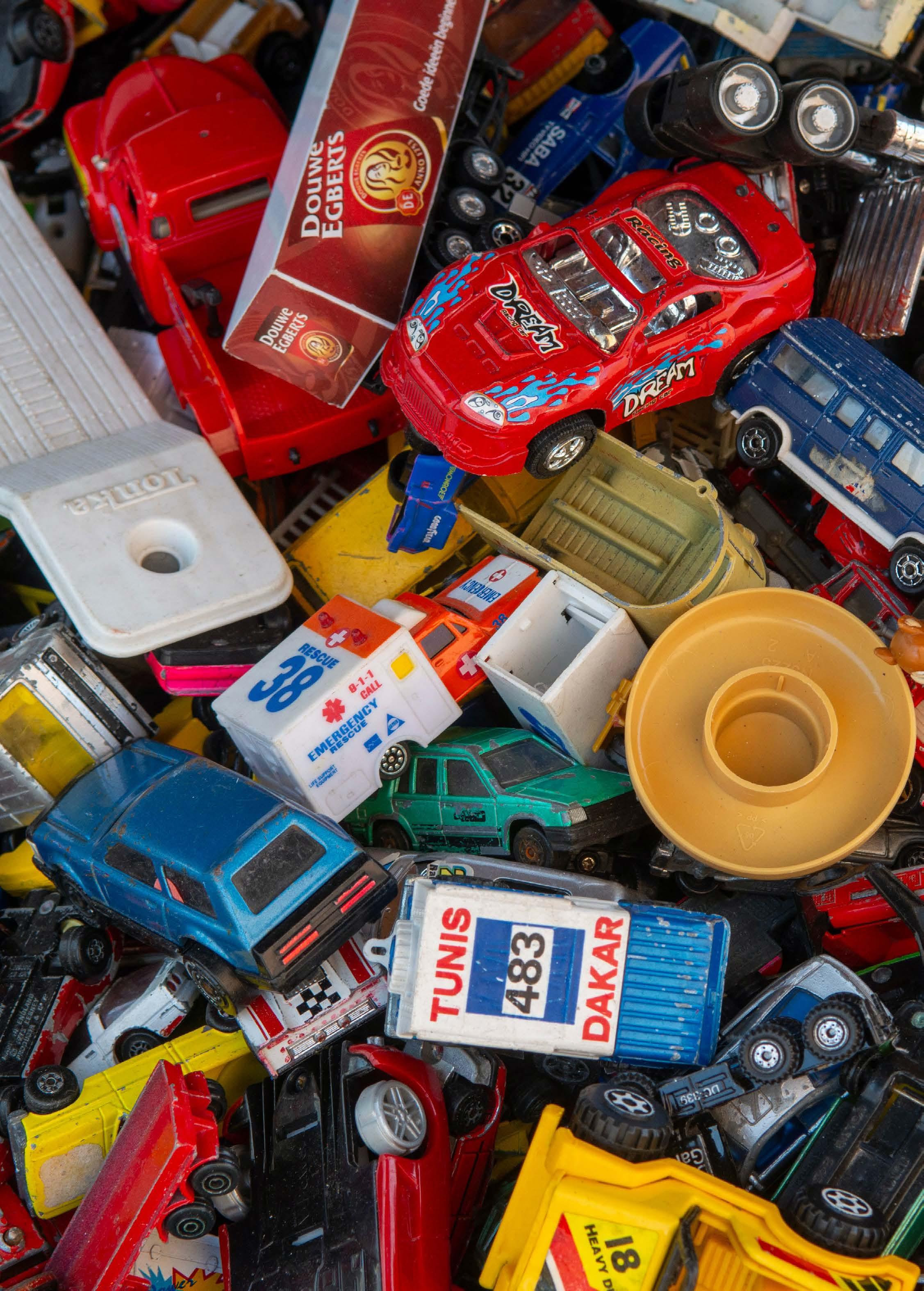
CARBON | 2023 54
LIFE IN PLASTIC: IS IT FANTASTIC?
A significant subset of planetary pollution is caused by plastic waste. Be it water bottles, bags, packaging, toys, clothes, or construction—plastic is everywhere. It has made its way into the soil, rainwater and even into the human body. As most plastic used today is non-biodegradable, it accumulates in landfills as consumption steadily increases. In 2019, we produced 450 million tons of plastic globally.31 An estimated 9% of that was recycled, while the rest was dumped or incinerated. With so much plastic in the world, it has actually been considered as one of the geological markers of the Anthropocene era.32
What is plastic made of at a chemical level? Once again, we find that carbon is at the centre stage. The process of plastic production starts with crude oil. Extracted crude oil is a blend of different hydrocarbons which are then separated through the process of fractional distillation. One of the distilled components is naphtha—a family of volatile hydrocarbons. Naphtha is purified under high temperatures to obtain lighter hydrocarbons like ethylene, propylene and butane. These smaller molecules are then made to polymerize, or form chains, to create granules or powders which are the basis for plastics. After this, factories heat, mould and solidify the plastic into objects for use.33 This process is then repeated, again and again, to cater to linear economies of scale and profit-driven planned obsolescence.

31 Ritchie, Samborska, and Roser, 2023.
32 Zalasiewicz et al., 2016.
33 Krosofsky, 2021.
55
In this crossword, fill in chains of letters to explore the myriad ways plastic influences our life and culture.
Spider Man is to Peter Parker as Plastic Man (superhero created by Jack Cole, appearing in Police Comics) is to _________.
PFOA, a known carcinogen, was used in this coating that makes cooking easier; also the centre point of the movie Dark Waters.
Tiny pieces of plastic made reflective by coating with aluminium; found in cosmetics and party supplies.
Movie in which an iconic group of girls is called ‘The Plastics’.
Which type of plastic is used in packaging mineral water?
A synthetic fibre with exceptional elasticity used to make summer sports attire; an anagram of the word ‘expands’.
The resin identification code (RIC) found on PVC pipes.
The Great _______ Garbage Patch is the largest accumulation of plastic in the open ocean.
A synthetic fibre with incredible tensile strength—10 times stronger than steel, used primarily in personal protection equipments.
This word in Latin means ‘I assembled’, originally made of wooden blocks that could be assembled to create structures.
Most modern plastics are derivatives of ___________.
A plastic doll lineup in the US; the primary rival of Barbie.
Most aircraft windows are made of this.
Plastic particles that are smaller than 5mm in size.
Name of the first plastic, invented in 1907.
A type of plasticizer, primarily used to soften PVC. Plastic man of India who patented the use of plastics in road construction.
REFLECT:
1. Different types of plastics can be identified using their Resin Identification Code (RIC)— little triangles with different numbers in them. Look for different objects around you made of different types of plastics by looking at their RIC.
2. What are some unexpected instances where you found plastic being used as a material?
CARBON | 2023 56
1 2 4 5 6 11 12 13 14 3 7 8 9 10 15 16 17
DOWN
ACROSS
space to write your words 57 1 3 2 4 5 6 7 8 9 10 11 14 13 12 16 17 15
GLOSSARY
ALLOTROPES
ANTHROPOCENE
BELL CURVE BITUMEN
The property of some chemical elements to exist in two or more different forms, in the same physical state.
The current geological age, viewed as the period during which human activity has been the dominant influence on climate and the environment.
In statistics, a bell-curve distribution is a type of continuous probability distribution for a real-valued random variable; the graph is shaped like a bell.
A black viscous mixture of hydrocarbons obtained naturally or as a residue from petroleum distillation. It is used for road surfacing and roofing.
CARBON NANOTUBES
CARBON SINKS
CARBONATION
A tube made of carbon with a diameter in the nanometer range (nanoscale).
A forest, ocean, or other natural environment viewed in terms of its ability to absorb carbon dioxide from the atmosphere.
Addition of carbon dioxide gas to a beverage, imparting sparkle and a tangy taste and preventing spoilage.
CHEMICAL BONDS
CONDUCTOR
FOSSIL FUELS
GREENHOUSE EFFECT
A strong force of attraction holding atoms together in a molecule or crystal, resulting from the sharing or transfer of electrons.
A material or device that conducts or transmits heat or electricity.
A fuel (such as coal, oil, or natural gas) formed in the earth from plant or animal remains.
Warming of the surface and lower atmosphere of a planet that is caused by conversion of solar radiation into heat in a process involving selective transmission of shortwave solar radiation by the atmosphere, its absorption by the planet’s surface, and reradiation as infrared which is absorbed and partly reradiated back to the surface by atmospheric gases.
CARBON | 2023
58
STENT
TRANSISTOR VALENCY
The combining power of an atom as shown by the number of electrons in its outermost energy level that are lost, gained, or shared in the formation of chemical bonds. SEQUEST
To form a stable compound with (an ion, atom, or molecule) so that it is no longer available for reactions.
A short narrow metal or plastic tube often in the form of a mesh that is inserted into the lumen of an anatomical vessel (such as an artery or a bile duct) especially to keep a previously blocked passageway open.
A solid-state electronic device that is used to control the flow of electricity in electronic equipment and usually consists of a small block of a semiconductor (such as germanium) with at least three electrodes.
59
REFERENCES
Aldis, Diane, Genevieve Muench, and Amy Fasteneau. 2018. “The Elements of Dance.” The Elements of Dance. 2018. https://www.ElementsOfDance.org/.
Arnold, Lois. 1984. Four Lives in Science: Women’s Education in the Nineteenth Century. New York: Schocken Books. https://archive.org/details/ fourlivesinscien00lois/page/125/mode/1up.
Baguley, Richard, and Colin McDonald. 2015. “Appliance Science: The Compressed Chemistry of Carbonation.” CNET, 2015. https://www.cnet.com/home/kitchen-andhousehold/appliance-science-the-compressed-chemistry-of-carbonation/.
Bawden, Tom. 2016. “How Liking Something on Facebook Can Damage the Planet.” The Independent, January 23, 2016, sec. Climate. https://www. independent.co.uk/climate-change/news/global-warming-data-centres-to-consumethree-times-as-much-energy-in-next-decade-experts-warn-a6830086.html.
Brown, Barbara N. 2002. “The First Photograph.” November 2002. https://cool. culturalheritage.org/byorg/abbey/an/an26/an26-3/an26-307.html.
CEIC. 2023. “Electricity Consumption: Utilities: Karnataka | Economic Indicators.” Ceicdata.Com. 2023. https://www.ceicdata.com/en/india/electricity-consumptionutilities/electricity-consumption-utilities-karnataka.
Fabbri, Malin. 2021. “The History of Anthotypes.” AlternativePhotography. 2021. https://www.alternativephotography.com/the-history-of-anthotypes/.
Foote, Eunice. 1856. “Circumstances Affecting the Heat of Sun’s Rays.” American Journal of Art and Science 22: 382-383.
Gangopadhyay, Uttara. 2023. “Heritage In My Beverage India’s Iconic Sodas.” Outlook Traveller. May 17, 2023. https://www.outlooktraveller.com/explore/food-anddrink/heritage-soda-and-beverage-brands-of-india.
Gerstner, Ed. 2010. “Nobel Prize 2010: Andre Geim & Konstantin Novoselov.” Nature Physics, 2010. https://www.nature.com/articles/nphys1836.
Google Sustainability. 2023. “Sustainable Innovation & Technology.” https://sustainability.google/reports/google-2023-environmental-report/.
Greta. 2023. “What Is Conservation? The Struggle over Boundaries and Definitions.” Current Conservation (blog). March 15, 2023. https://www.currentconservation.org/ what-is-conservation-the-struggle-over-boundaries-and-definitions/.
CARBON | 2023
60
Griffiths, Sarah. n.d. “Why Your Internet Habits Are Not as Clean as You Think.” Accessed January 11, 2024. https://www.bbc.com/future/article/20200305why-your-internet-habits-are-not-as-clean-as-you-think.
Hazen, Robert M. 2019. “Why Carbon?” Scientific American Blog Network. 2019. https://blogs.scientificamerican.com/observations/why-carbon/.
Helion, Courtney, Joan Walker, and Constance McCabe. n.d. “Carbon Prints.” National Gallery of Art. Accessed January 3, 2024. https://www.nga.gov/ research/online-editions/alfred-stieglitz-key-set/practices-and-processes/carbonprint.html.
Hickman, Caroline, Elizabeth Marks, Panu Pihkala, and Lise van Susteren. 2021. “Climate Anxiety in Children and Young People and Their Beliefs about Government Responses to Climate Change: A Global Survey.” The Lancet Planetary Health 5 (12): e863–73. https://doi.org/10.1016/S25425196(21)00278-3.
Kemp, John, and John Kemp. 2023. “China and India Struggle to Curb Fossil Fuels.” Reuters, October 19, 2023, sec. Commodities. https://www.reuters.com/ markets/commodities/china-india-struggle-curb-fossil-fuels-kemp-2023-10-19/.
Krosofsky, Andrew. 2021. “The Plastic Making Process Is Harmful to the Environment — Here’s Why.” Green Matters. August 12, 2021. https://www. greenmatters.com/p/how-plastic-made.
McMillen, Stuart. 2015. “Peak Oil Comic about Fossil Fuel Depletion.” 2015. https://www.stuartmcmillen.com/comic/peak-oil/.
Nguyen, Bich Ha, and Van Hieu Nguyen. 2016. “Promising Applications of Graphene and Graphene-Based Nanostructures.” Advances in Natural Sciences: Nanoscience and Nanotechnology 7 (2): 023002. https://doi. org/10.1088/2043-6262/7/2/023002.
Obringer, Renee, Benjamin Rachunok, Debora Maia-Silva, and Kaveh Madani. 2021. “The Overlooked Environmental Footprint of Increasing Internet Use.” Resources, Conservation and Recycling 167 (April): 105389. https://doi.org/10.1016/j.resconrec.2020.105389.
Pauling, Linus. 1948. “The Modern Theory of Valency.” Journal of the Chemical Society. https://pubs.rsc.org/en/content/articlelanding/1948/jr/ jr9480001461/unauth.
61
PubChem. 2004. “Curcumin.” National Library of Medicine. 2004. https:// pubchem.ncbi.nlm.nih.gov/compound/969516.
Ritchie, Hannah, Veronika Samborska, and Max Roser. 2023. “Plastic Pollution.” Our World in Data, November. https://ourworldindata.org/plasticpollution.
Rogers, Adam. 2017. “Art Fight! The Pinkest Pink Versus the Blackest Black.” WIRED, 2017. https://www.wired.com/story/vantablack-anish-kapoor-stuartsemple/.
Science and Industry Museum. 2021. “Graphene: A New Way of Thinking about Materials,” November 25, 2021. https://www.scienceandindustrymuseum.org. uk/objects-and-stories/graphene.
Sharma, Pawankumar, and Bibhu Dash. 2022. “The Digital Carbon Footprint: Threat to an Environmentally Sustainable Future” 14 (July): 19–29. https://doi. org/10.5121/ijcsit.2022.14302.
Terry, Walter. 1942. Invitation to Dance. A. S. Barnes.
United Nations. n.d. “From Stockholm to Kyoto: A Brief History of Climate Change.” Accessed November 10, 2023. https://www.un.org/en/chronicle/article/ stockholm-kyoto-brief-history-climate-change.
Wang, Yuanyuan, Rui B.Chang, and Emily R.Liman. 2019. “TRPA1 Is a Component of the Nociceptive Response to CO2 | Journal of Neuroscience.” Journal of Neuroscience 30 (39): 12958–63. https://doi.org/10.1523/ JNEUROSCI.2715-10.2010.
Wassei, Jonathan K., and Richard B. Kaner. 2010. “Graphene, a Promising Transparent Conductor.” Materials Today 13 (3): 52–59. https://doi. org/10.1016/S1369-7021(10)70034-1.
Worldfavour. n.d. “The Growing Carbon Footprint of Digitalization and How to Control It.” Accessed January 11, 2024. https://blog.worldfavor.com/thegrowing-carbon-footprint-of-digitalization-and-how-to-control-it.
Zalasiewicz, Jan, Colin N. Waters, Juliana A. Ivar do Sul, Patricia L. Corcoran, Anthony D. Barnosky, Alejandro Cearreta, Matt Edgeworth, et al. 2016. “The Geological Cycle of Plastics and Their Use as a Stratigraphic Indicator of the Anthropocene.” Anthropocene 13 (March): 4–17. https://doi.org/10.1016/j.ancene.2016.01.002.
CARBON | 2023
62
IMAGE CREDITS
PAGE 04
PAGE 08
PAGE 14
PAGE 18
PAGE 26
PAGE 32
Into the Nanoverse
Photo: AbsolutVision on Pixabay
Element Embroidery
Photo: Merve Sehirli Nasir on Unsplash
Let’s Get Fizzy
Photo: Rathaphon Nanthapreecha on Pexels
Turn Over a New Leaf
Photo: Fatih Turan on Pexels
Cucurmin Clicks
Photo: Anastasia Pavlova on Pexels
Dear (Digital) Diary
Photo: Wex Cockx, created as a part of Visualizing AI project for Google DeepMind
PAGE 36
PAGE 42
PAGE 48
PAGE 52
Fuel for Thought
Photo: 陈敏 同学 (Chén min tóngxué) on Pexels
A Foote note in Climate History
Photo: Markus Distelrath on Pexels
Poem: Kleon, Austin. 2023. ‘I Made You Some Poems’. Substack newsletter. Austin Kleon. May 2. https://austinkleon.substack. com/p/i-made-you-some-poems.
Choreographing Carbon
Photo: Cottonbro studio on Pexels
Life in Plastic: Is it Fantastic?
Photo: Jan van der Wolf on Pexels
CROSSWORD ANSWERS
63
EEL 2. TEFLON 3. LEGO 4. GLITTER 5. MEANGIRLS 6. PET 7. PETROLEUM 8. BRATZ 9. PLEXIGLASS 10. MICROPLASTICS 11. SPANDEX 12. THREE 13. PACIFIC 14. KEVLAR 15. BAKELITE 16. PHTHALATE 17. VASUDEVAN
1.
NOTES
CARBON | 2023
64

Psst, use this space to play dots and boxes!

CARBON | 2023
CC BY-NC-ND 4.0




























































